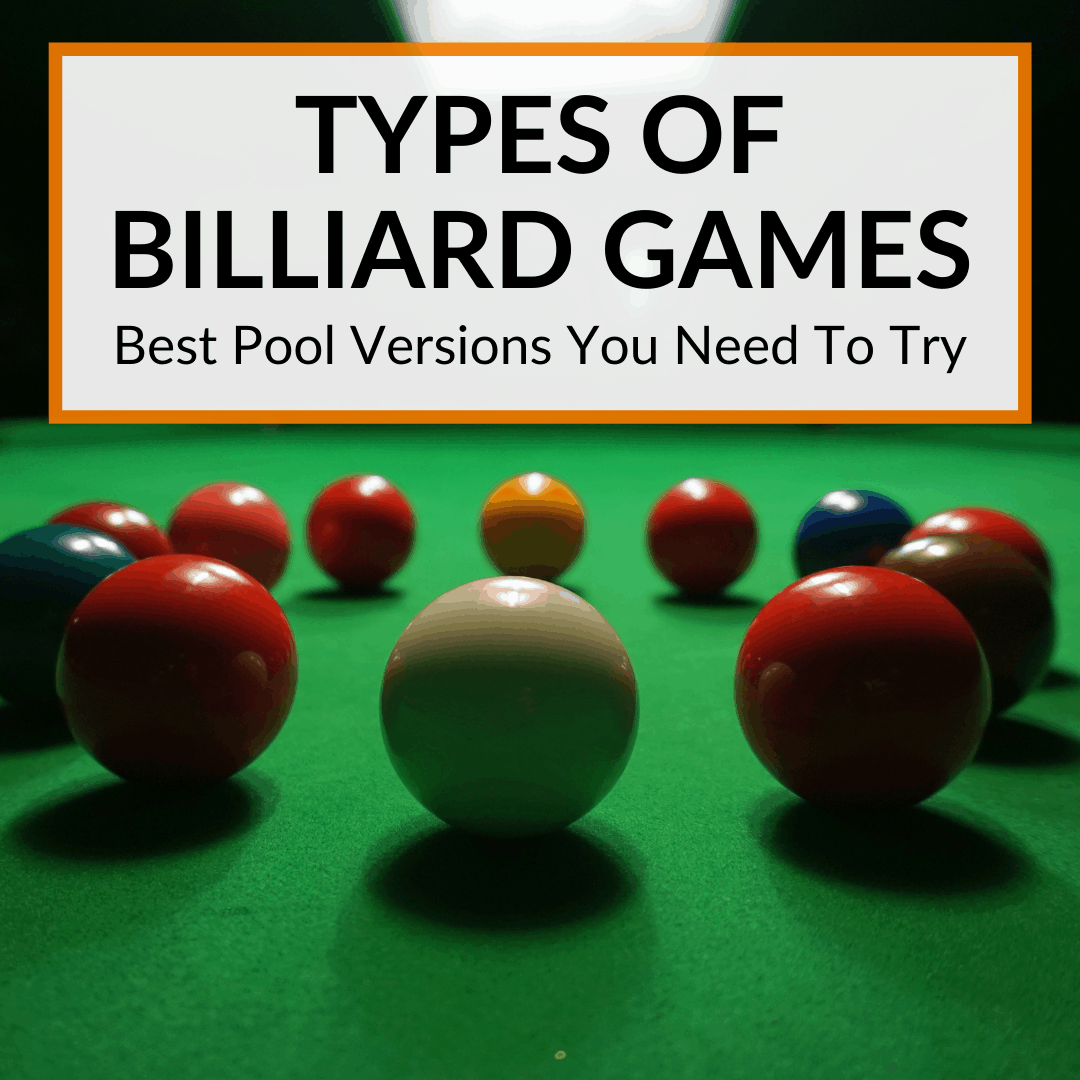 Ever seen a billiard table with no pockets?
Ever seen a billiard table with no pockets?
Ever watched a game on a billiard table using only three balls and wondered what that is?
They are all different types of billiard games. Collectively they are known as “cue sports.”
Pool, carom billiards, and snooker are three main categories of billiard games. Each of them has multiple subcategories with specific rules.
The most obvious differences are the table size and design, along with the size, color and number of balls.
Keep reading to learn all about each type of billiard games.
Table of Contents
What Is A Billiard Game?
Before getting into the differences, let’s talk about the similarities. Every game played on a clothed table with a cue stick and balls is a billiard game.
Most billiard games are played indoors. They differ in the shape of the table, the number of balls and also the pool ball colors and numbers.
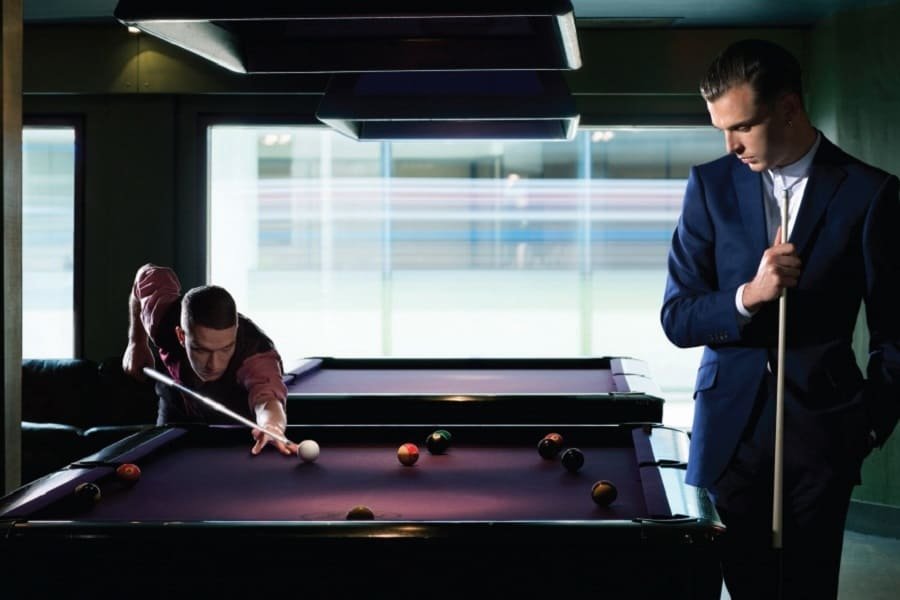
Some games are played with eight balls, some with nine, some with three, and some with far more. In most games, players want to put the balls in table pockets. Others are played on tables without pockets.
Let’s take a closer look at the most popular billiard games.
Types Of Billiard Games
Pool games are the most famous type of billiard games. They have some subcategories, among which the game called “8 ball” is the most popular.
Snooker is another type of billiard game, also played on a table with pockets. It’s the longest type of billiard game with 22 balls. Most of the balls are red. There are some other colored balls with a cue ball as well.
There are multiple rules for various kinds of snooker games. They differ in the number of red balls. The most popular snooker game is played with 15 red, 6 colored, and one cue ball.
Carom Billiards is a well-known billiard game that is played on a table without pockets. The table for carom billiards is covered with rails. Two players play this game using three balls.
We’ll begin by taking a closer look at the most common billiard game.
American Eight-Ball
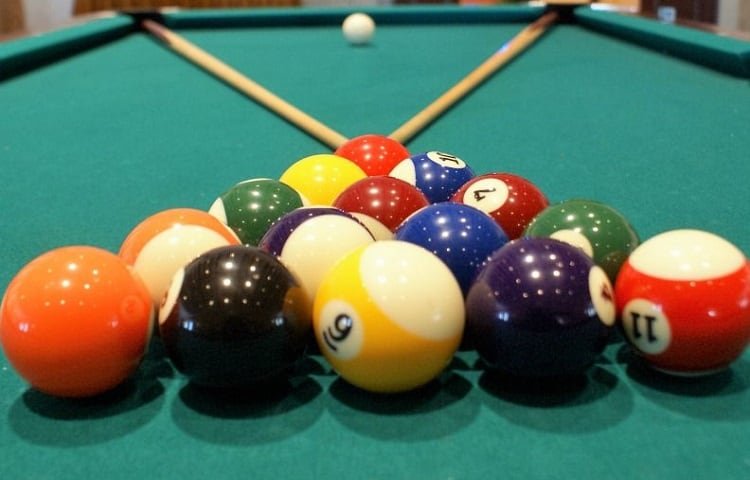
This is pool as you know it. American eight-ball is sometimes also just called 8 ball pool with no nationality of credit.
You might also know this as simply playing stripes and solids. We’ll go over all the basics of it, so if this is your first time playing standard pool, you’ll know everything that you need to.
How To Play
The 8 ball game is played with 16 balls. In most cases, these pool balls are made of phenolic resin. 15 of them have numbers. Balls number 1 to 7 are colored solid, while balls 9 to 15 are striped.
You probably noticed the missing 8 ball. It is also colored solid, but it is black and fills a special role. The final ball is the while cue ball.
You play this game by shooting the cue ball with a cue stick. Your goal is to hit the object balls with the cue ball and put them in the pockets around the table.
There are always two balls of the same color in the eight-ball game, with one of the pair being solid and the other striped. Some pool halls and bars may use alternative colors. But the standard colors for the balls are:
- Yellow: 1 and 9
- Blue: 2 and 10
- Red: 3 and 11
- Purple: 4 and 12
- Orange: 5 and 13
- Green: 6 and 14
- Maroon: 7 and 15
- Black: 8
- White: Cue
The eight-ball game’s ultimate goal is to put the numbered 8 ball – AKA blackball – in a pocket. But before that, the players need to put all of their specific colored balls into the pockets.
The game starts by placing the balls in a triangular rack. The triangle is placed in such a way that the apex ball is on the footnote.
The black 8 ball sits in the center. All of the balls should be in contact with each other. The triangular rack is placed parallel to the end rail.
One of the players shoots the rack. This is called the break shot. The breaking player is chosen by coin flip or other similar method.
The breaker should shoot the rack in such a way that at least four balls hit the cushions. It’s even better if at least one of them goes into a pocket. If you sink the 8-ball on the break (without also sinking the cue ball or sending it off the table), you win the game.
In some rulings, you just play to sink any ball you can at first (minus cue and eight ball), and whichever one that was (solids or stripes) is the goal you’re assigned. In other words, if you pocket a colored ball, you must then pocket the other colored balls.
In pool halls, you typically call which one you’re going for after the break before sinking any. Just be sure that this detail is discussed before you start getting deep into the game.
If no fouls occur, you continues pocketing until only the 8 ball remains. Pocketing the numbered 8 ball clinches victory. If a foul occurs, your opponent takes over and tries to pocket all of their balls.
Fouls
If you commit one of the fouls below, your opponent takes over shooting. Some of them result in a ball-in-hand situation. This enables your opponent to position the cue ball manually, wherever they please. These are the possible fouls.
- Failing to hit the object ball with the cue ball
- Not having at least one foot on the floor
- Pocketing the cue ball
- No ball is pocketed during the break
- Knocking a ball off the table
- Touching a ball with hands
- Hitting the wrong ball first regarding the solid and stripes, i.e. hitting a ball belonging to your opponent
Straight Pool
Straight pool is a variation similar to American eight-ball pool, but with a few different twists. Straight pool is best used to differentiate your pool playing style, and to have something slightly different to play.
How To Play
You rack up balls like you normally would (15 in the rack), except the yellow number one ball goes in the back left corner, while the red number five ball goes in the back right corner. It’s important to note that these are both solids, not stripes.
Straight pool is also called 14.1 continuous and 14.1 rack, which are specific, niche names that you’re not going to hear around the pool hall. This initial name was derived around 1910 when this game variant was played for the first time.
The goal is not to sink solids or stripes, but to sink any ball on the table except the cue ball. That includes the eight ball.
If you do sink the cue ball, you simply lose that turn and your opponent is able to re-position the ball anywhere behind the second dot zone on the table.
You can set a rule that sinking the cue ball is an automatic end to the game, but the issue here is that you could actually win the game if you intentionally sink the cue ball when you have more points, so this rule is often not used.
Typically, you play until 125 or 150 points. That sounds rough, but that doesn’t mean sinking 125 separate pool balls (nobody has time for that). Each ball has its own point value.
Red pool balls are one point, yellow pool balls are two points, green pool balls are three points, brown pool balls are four points, blue pool balls are five points, pink are six points, and the eight ball is worth seven points.
Once all the balls have been sunk, you re-rack them. If you sink every single ball on the table, that’s 49 points total, so no matter what, there will be at least two re-rackings, apart from the beginning one.
Straight pool is also riddled with tons of rules, which is a bit odd considering this is a more casual game that you’re supposed to enjoy with fewer restrictions.
This is the type of pool many people play with a lot of the official rulings (such as 15th pocket rules and what not) off the table. Have a drink and use a pencil and a napkin to keep score, and have fun with it.
English Billiards
This version of pool is actually quite different. You don’t just use the standard pool balls and cues, but with a different set of rules.
This game variant is also played in Australia, and is considered to be the first version of pool to be popularized in pubs. Naturally, we Americans turned the game into something else entirely.
How To Play
Set up your pool balls by using a plain white ball on one side, a ball with a white spot on the other, and a red ball. These are lined up all on the same side. The issue here is finding English billiards balls, since standard pool balls are much more common in the US.
If you receive a penalty, your opponent receives a point. You can score successfully and avoid penalties by scoring points (simple enough).
You gain three points if the red ball was first struck by the cue ball, not another ball or banking off the edge/rails.
English billiards, even when played between friends in a pub, often has a referee who can call the end of the game at any time (with good sportsmanship in mind, of course).
There is a long list of fouls, such as playing a jump shot at all, out of turn plays, double striking the cue ball, and tons of others. The list of rules in English billiards is long and complex.
English billiards isn’t played often anymore because it gets very in-depth in a way that confuses more than it excites. There are, of course, still hardcore English billiards players out there. But in general, you’re going to run into far more standard Americanized billiards/pool players.
Snooker

Snooker is a variant of pool that is extremely simple to master, and usually used to have fun without letting a ton of rules get in the way. This simple barroom game is something that you can do while having a few drinks, as long as you have a pencil and a napkin to keep score.
Snooker is also used to just shoot pool and have fun with it without keeping score, making it one of the most casual pool games out there.
How To Play
Two players each grab their cues. You don’t need a referee here. Start with a 12′ long table (standard pool table dimensions are 7′ or 8′ by 4.5′ wide). Snooker can still be played with normal pool balls and a pool table, you just have to adjust the rules.
You shoot to score; not for solids or stripes. Generally, snooker is played with twenty-two balls instead of just the standard fifteen in billiards/pool.
Usually, there are just six colors for snooker balls and they each have their own scores. In total, you have the following balls:
- 15 red balls
- 6 colored balls
- One cue ball
The red balls are placed in a triangular rack. The six colored balls have standard positions. The players should pocket a red ball first. Then they choose a colored ball to the pocket.
The pocketed red ball will stay in the pocket. But the colored ball will be spotted again on the table. The game continues until all of the red balls are pocketed. Then, the players start pocketing the colored balls. The player with the highest score wins the game.
Each snooker ball has a unique point value, as follows:
- Black: 7
- Pick: 6
- Blue: 5
- Brown: 4
- Green: 3
- Yellow: 2
- Red: 1
Snooker is considered one of the most professional billiard games. It includes precise score calculating. Calling the balls is recommended in this game, too. Standard foul rules are:
- Not hitting the indicated ball. But if shooting the red balls, any ball is accepted.
- Jumping a ball off the table
- Pocketing the cue ball
Cutthroat Pool
Cutthroat pool is actually a three-person variant of the game, meaning you’ll be up against two opponents in a free-for-all rule set that pits everyone against each other. You don’t have to focus on solids or stripes here: each player will get five balls, (1-5, 6-10, and 11-15) to duke it out with.
How To Play
You’re not playing to sink your own balls in the pockets—you’re actually trying to sink your opponent’s balls until they have none left. Once you know what an opponent’s ball set is, whether that’s numbers or you play a two-person set with colors, your goal is to ruin them.
You can cut your own throat, which is when you sink one of your own balls intentionally, because it will then extend the turn back to you. This can be used to get better positioning. But make sure you know what you’re giving up for it!
To win, you need to have at least one ball remaining in play.
If you knock the cue ball into any pocket, you not only lose that turn, but your opponent is allowed to retrieve one of their balls that went out of play and put it back on the table.
Another foul is hitting the cue ball twice in the same shot, so if your ball bounces off the rails and hits the cue ball again, it’s a foul and you lose that turn.
One Pocket Pool
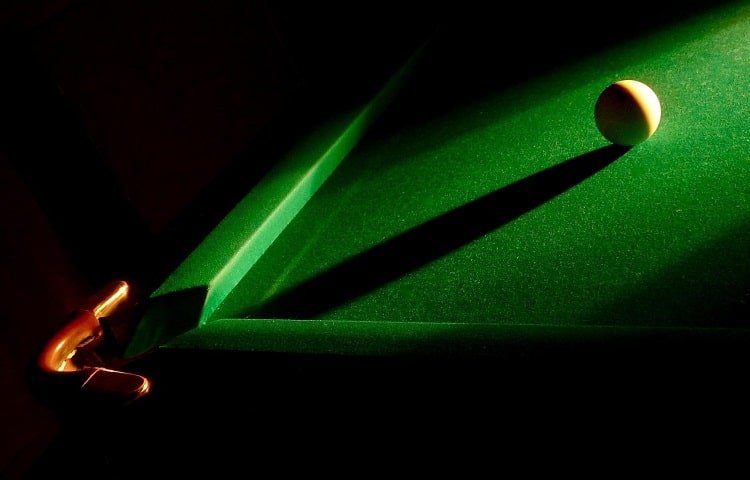
The name gives it all away—it’s a game of pool where you each focus on one pocket, and that pocket cannot be the same one!
How To Play
Two players use standard pool rules, cues, and balls, playing solids and stripes. The difference is that you have to call a pocket at the beginning of the match.
Once you call one of the six pockets, that is the only pocket you are allowed to sink balls into for the entire game. If you sink your ball into another pocket, it’s a foul. You cannot sink your ball into an opponent’s pocket no matter what.
Each ball is equivalent to one point. This means that you need eight points in total to claim victory. The eight ball is not an automatic loss. It is treated as just another ball.
9 Ball
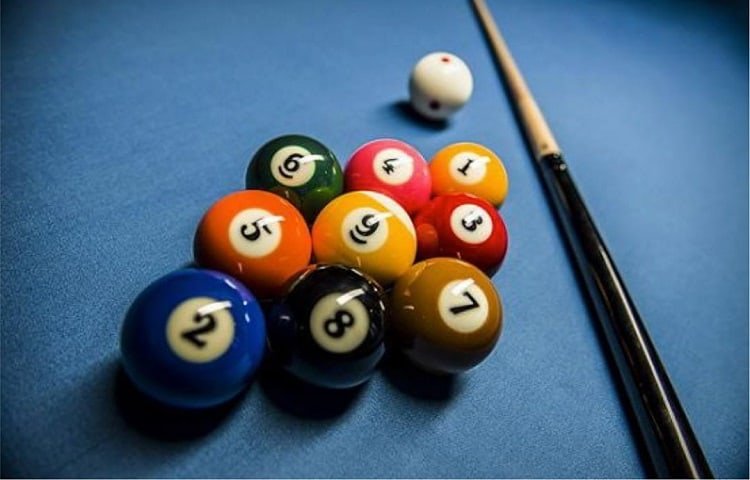
9-ball is another pool game. It is similar to other pool variants, like 8-ball. You play it on the same table, generally made from wood or slate, and with the same balls, but the number of balls differs.
This game is played with 9 balls and a cue ball. The players hit the balls with the cue ball using their stick. The ultimate goal is to put the numbered 9 ball in a pocket.
How To Play
To begin, take the balls numbered 1 to 9 and put them in a diamond rack on the billiard table. The number 1 ball should face the shooter. The number 9 ball is in the center of the diamond. All other balls are placed randomly.
The game starts with one of the players hitting the 1-ball with the cue ball. In the next shots, you should always hit the ball with the lowest number.
You can pocket other balls – including the 9 ball – with combination shots. You have to hit the ball with the lowest number on the table first, but you can then pocket any other ball after having hit the lowest one.
If you pocket a ball on the break, you can call a “push out.” It has specific rules. In push-out shots, you don’t necessarily follow the 9 ball rules. You can shoot in any way you want. Only shooting a ball off the table is considered a foul in the push-out shot.
The player that puts the number 9 in a pocket wins the game.
The fouls in the 9 ball game are similar to 8 ball, with some minor differences. Some of them are:
- Knocking any ball off the table
- Pocketing the cue ball – even with the object ball
- Not having at least one foot on the floor
3 Ball
This is a pool game with fewer standard rules. There are only three balls in this game. The color of the three balls is not important. But one of them has to be the cue ball.
Any number of players can play the 3 ball pool game. But playing the game with five players is most common.
How To Play
The 3 ball pool game is simple. The ultimate goal is to pocket all of the three balls with the fewest shots.
The players all take turns at pocketing all of the balls. After every player has played the game, the one who took the fewest shots to pocket all of the balls is the winner.
The 3 ball pool game has some specific rules. They’re different from other types of billiard games. It looks like a simple game but has a unique set of fouls. Some of the fouls are:
- Pocketing the cue ball
- Double jump of the cue ball
- Pocketing the cue ball as well as the object ball
- Knocking the cue ball off the table
Bank Pool
Another type of billiard game that limits the pockets is the bank pool. Only bank shots are accepted.
The game’s object is to pocket eight balls in bank pockets – if playing with a full rack. The game is known as the cleanest pool game.
How To Play
Two individuals or teams should play the bank pool game. The first one to pocket eight balls in bank pockets wins the game.
Place the balls in a triangular rack randomly. A legal break is when the cue ball hits an object ball, and at least two object balls contact a cushion.
If any ball is pocketed in the break, the player continues the inning. But the pocketed balls will not count. They should be spotted again at the end of the breaker’s inning. Putting object balls in corner pockets stops the inning.
Each foul means a penalty for the player, and their previously pocketed ball will be spotted again on the table. Three successive fouls mean losing the game. Fouls include:
- Jumping the cue ball off the table or scratching the cue ball
- Not hitting the called object ball with the cue ball.
Carom Billiards
Carom billiards is the only type of billiard game that is played on a table without pockets.
The game is usually played with three balls – red, yellow, and white. White and yellow balls are cue balls in this game. The red one is always the object ball.
The table of the carom billiards is covered with rails. There are various types of carom billiards. Straight rail is the most popular.
In the straight rail carom billiard, the players shoot the other balls with the cue ball. If they hit the other two object balls back-to-back, they score.
Different Types Of Billiard Games: Final Thoughts
There are so many different types of billiard games out there apart from the common 8-ball game. Most of them are tons of fun, too.
We highly recommend giving some of the other games a try, especially the ones that use the same table and balls as 8-ball. Our billiard tips can help with most types of games.
Some of the other games, like snooker, require different equipment, although you can adapt them to work with the standard pool equipment too. Even if you have a good portable billiard table, you can play snooker on it, though it is obviously much smaller than a snooker table.
Your best bet is to find a pool hall that has snooker tables too. These are much more common in the UK than in the US.
Leave a Reply